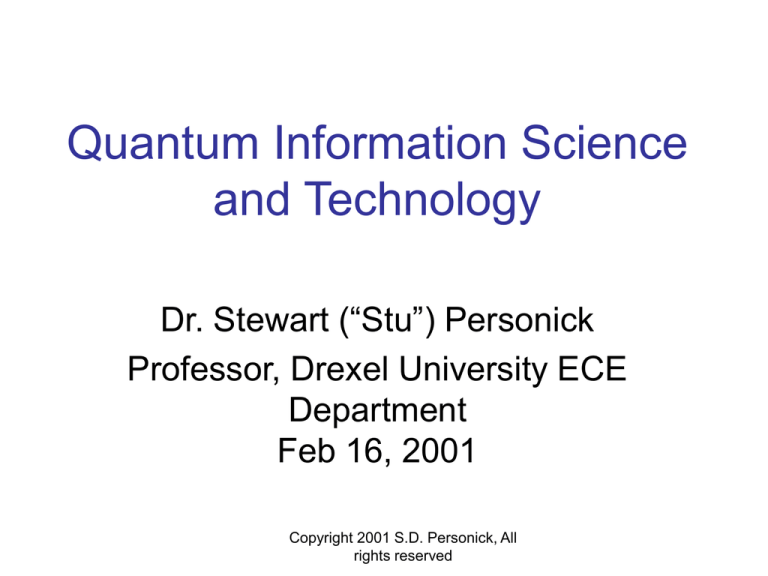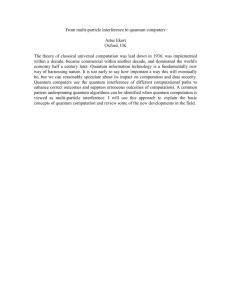
Quantum Information Science
and Technology
Dr. Stewart (“Stu”) Personick
Professor, Drexel University ECE
Department
Feb 16, 2001
Copyright 2001 S.D. Personick, All
rights reserved
Quantum Information Science
and Technology
• Using the “weird” properties of the
physical world, that are predicted by the
quantum theory, to:
-make computers that can perform
computations, in reasonable amounts of
time, that appear to require impractically
large amounts of time using classical
computers (e.g., find the factors of a
large number)
Copyright 2001 S.D. Personick,systems
All
-construct communication
with
rights reserved
Quantum Information Science
and Technology
• Some history:
-1920’s…scientists invent the quantum
formalism to provide a mathematical
framework for “predicting” (retroactively)
certain puzzling observations…e.g., why
don’t electrons spiral into the nucleus of an
atom?
-this quantum formalism predicts all sorts of
weird and non-intuitive things… e.g., the EPR
thought experiment
-1990’s… when
technology
evolves
to the
Copyright
2001 S.D. Personick,
All
rights reserved
point where experiments
can be
Quantum Information Science
and Technology
•
The more you think about, and
understand quantum theory and its
implications… the more uneasy you
become: e.g.,
Anybody who is not shocked by
quantum theory
has not understood it ---Niels Bohr
Copyright 2001 S.D. Personick, All
rights reserved
Quantum Computation
• The simplest physical system, such as
an electron in spin state “up” or “down”,
can be modeled as having a “state” that
is a vector |1>
in a two-dimensional space
|s>= a|1> + b |0>
|0>
Copyright 2001 S.D. Personick, All
rights reserved
Quantum Computation
• The quantum state of a physical system
represents the entire physical reality of
the physical system (no “hidden
variables”).
|1>
|s>= a|1> + b|0>
|0>
Copyright 2001 S.D. Personick, All
rights reserved
Quantum Computation
• The quantum state of a physical system
evolves, in time, according to
Schrodinger’s equation:
[ ih/2pi]
|1> d/dt|s> = H|s>
|s>= a|1> + b|0>
|0>
Copyright 2001 S.D. Personick, All
rights reserved
|1>
|s>= a|1> + b|0>
Quantum Computation
|0>
• The quantum state of a physical system
evolves, in time, according to Schrodinger’s
equation:
[ ih/2pi] d/dt|s> = H|s>
• We can perform a computation by preparing
an initial state |s>, allowing it to interact with a
physical system (I.e., select H) of our choice,
and then performing a measurement on the
evolved state |s’>
Copyright 2001 S.D. Personick, All
rights reserved
Quantum Computation
• Is it real?
Several possible answers, including:
-yes, it is real…you can make real
systems that successfully implement quantum
computation
-no, there is a “showstopper” problem that
prevents us from making a system that
successfully implements quantum
computation…but we just haven’t thought of it
yet
Answering thisCopyright
question
whatAll the QuIST
2001 S.D.is
Personick,
reserved
program and relatedrights
research
efforts are
Example of a quantum logic
operation
|s> = a|1> +b|0>
|u>
|s>
|u>= |1> or |0>
Quantum
Controlled X
Operator
If |u>=|0>, then |s’> = |s>;
If |u> =|1>, then |s’>= a|0> + b|1>
Copyright 2001 S.D. Personick, All
rights reserved
|u>
|s’>
Example of a quantum logic
operation
(this stuff is weird)
|s> = a|1> +b|0>
|u>= c|1>+d|0>
|s> and |u> are “quantum bits”
(QuBits)
|u>
|s>
Quantum
Controlled X
Operator
|u>
|s’>
Output state is c[|1>(b|1>+a|0>)] +d[|0>( a|1> + b|0>)]
…the output QuBits are “entangled”
Copyright 2001 S.D. Personick, All
rights reserved
Example of a quantum logic
operation
(this stuff is weird)
|s> = |0>
|u>= [ |1>+|0> ] / (2**0.5)
|s> and |u> are “quantum bits”
(QuBits)
|u>
|s>
Quantum
Controlled X
Operator
|u>
|s’>
The output state is [|1>|1>] +[|0>|0>)]/ (2**0.5)
…one of the four “Bell States” or “EPR” pairs (Einstein,
Podolsky, Rosen) Copyright 2001 S.D. Personick, All
rights reserved
Schrodinger’s Cat
(When I hear about Schrodinger’s Cat…I reach
for my gun --- Stephen Hawking)
|s> = |alive>
|u>= [ |1>+|0> ] / (2**0.5)
|s> and |u> are “quantum bits”
(QuBits)
|u>
|alive
>
Quantum
Controlled Cat Killer
Operator
|u>
|s’>
The output state is [|0>|alive>] +[|1>|dead>)]/ (2**0.5)
Copyright 2001 S.D. Personick, All
rights reserved
Example of “communication”
at faster than the speed of
light
(this stuff is weird)
|s> = |0> |u>= [ |1>+|0> ] / (2**0.5)
|s> and |u> are “quantum bits”
(QuBits)
|u>
|s>
Quantum
Controlled X
Operator
|u>
|s’>
The output state is [|1>|1>] +[|0>|0>)]/ (2**0.5); If you
measure QuBit 1, to “determine” whether it is in state |0>
or state |1> , then you know the state of QuBit 2
Copyright 2001 S.D. Personick, All
rights reserved
Quantum Teleportation
EPR pair: |b> =
|x>
H
[ |1>|1> + |0>|0> ]
/ (2**0.5)
Measure
Measure
|b>
X
Alice
Copyright 2001 S.D. Personick, All
rights reserved
Z
Bob
|x>
Quick Review of Shannon’s
Formula
A
Coder
X
Channel
Y
B
Decoder
Source information rate = H(A)
I (X:Y)= Mutual information between X
and Y=
H(X) - H(X|Y)
where: h(u) = -p(u) log p(u); H
2001 S.D. Personick, All
(U)=sumCopyright
{h(u)}
rights reserved
Quick Review of Shannon’s
Formula
Coder
X
Channel
Decoder
Y
C (channel capacity) = H(X) H(X|Y)
maximized over all apriori probability
Channel input
distributionsChannel
of X
symbols output
{x}
symbols {y}
Copyright 2001 S.D. Personick, All
rights reserved
Applying Shannon’s formula to
an optical fiber link with
specific types physical
transmitters and receivers
Laser
Receiver
Fibe
r
Classical channel capacity:
C= B log[1 +
E/N] receiver case: N= hf Heterodyne receiver
Homodyne
case: N=2hf
Optical preamplifier: N=2hf
E/N ~P/hfB; for B=20 GHz, hfB ~3 x 10**-9 watts ~ 55 dBm
C (20 GHz, -25dBm ) ~ 20 GHz x 10 bps/Hz = 200
Copyright 2001 S.D. Personick, All
Gbps
rights reserved
C (20 GHz, -8 dBm ) ~ 20 GHz x 16 bps/Hz = 320
Extending Shannon’s formula
to an optical fiber link viewed
from the perspective of
quantum theory
Coder
fiber
Any physical transmitting subsystem
consistent with the laws of
Quantu
physics
m state
Any physical receiver consistent with Decoder
Quantuquantum measurement theory
m state
Copyright 2001 S.D. Personick, All
rights reserved
Special Case Ref: Yuen and
Ozawa
Physical Review Letters Jan 25,
1993
Assumption: the received signal is in a single
electromagnetic field mode, subject to a
constraint that the average received number of
photons (energy constraint), as defined by a
measurement of the “number operator”, is less
than N photons
c (capacity per use of the
channel)=
(n+1) log (n+1) - n log n
Copyright 2001 S.D. Personick, All
where n= E/hf,
andrightsEreserved
is the average
Special Case: Yuen and
Ozawa
Physical Review Letters Jan
25 use
1993
c (capacity per
of the channel)=
(n+1) log (n+1) - n log n =
log (n+1) + n log(1 + 1/n)
where n= E/hf, and E is the average energy per
received symbol.
n
.01 0.1 0.5 1.0 2.0 5.0 10.0
infinity
log (1+n)
.014 0.14 0.58 1.0 1.58 2.58 3.45
infinity
Copyright 2001 S.D. Personick, All
n log (1+ 1/n) .067
0.35
rights 0.79
reserved 1.0 1.17 1.32 1.38









